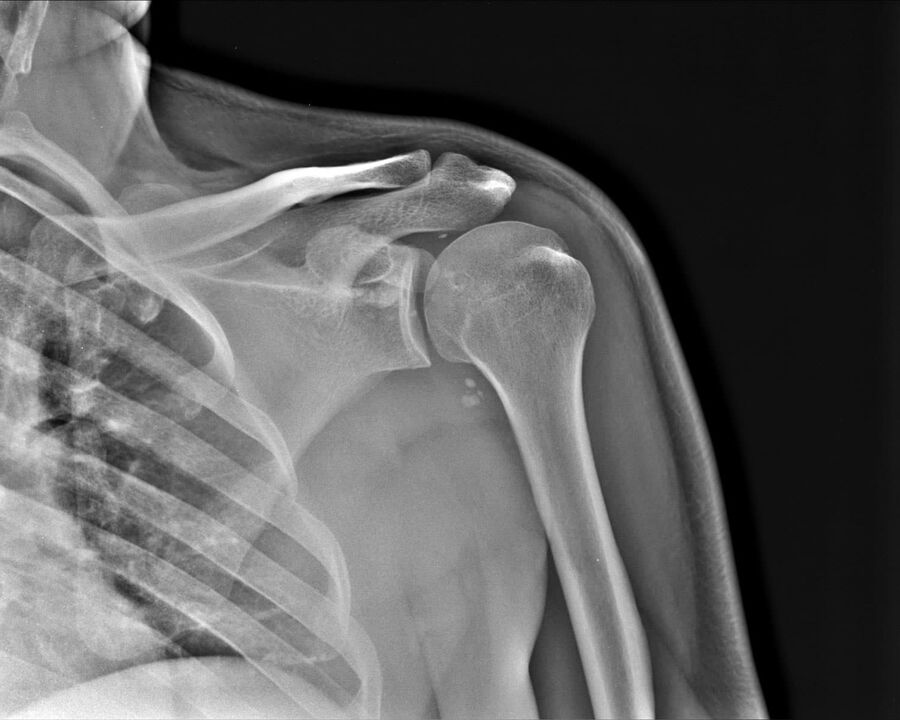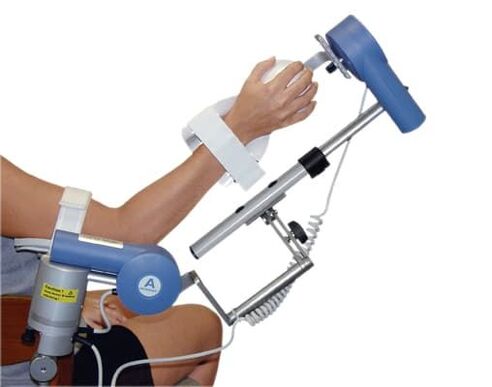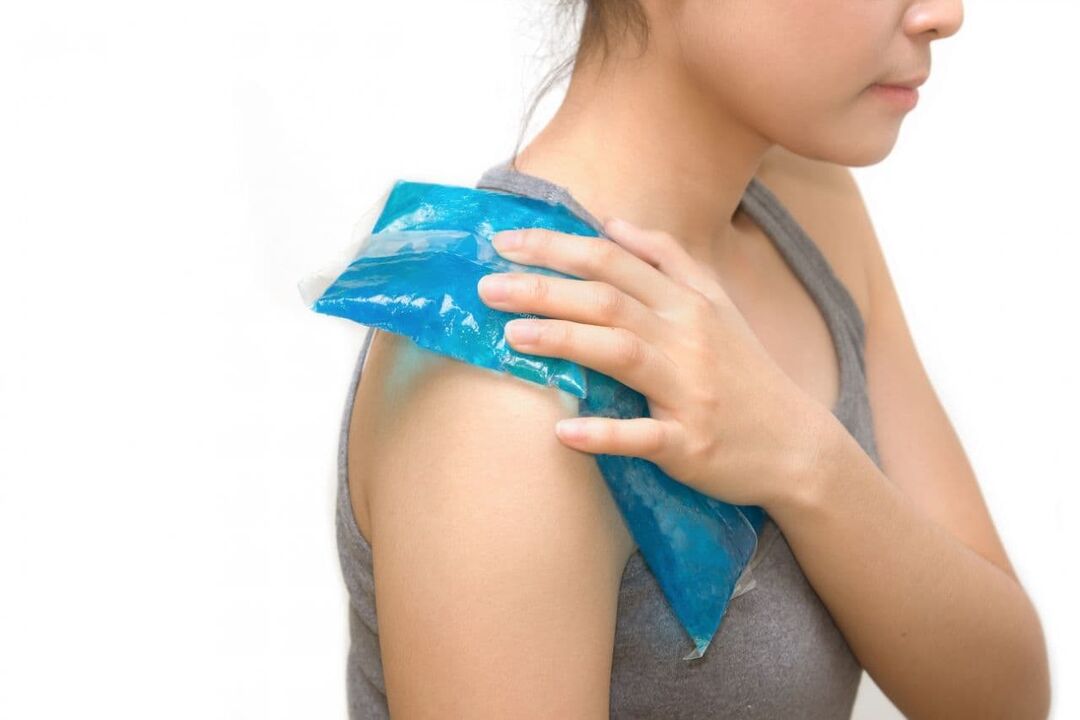Arthrosis (osteoarthritis) is a degenerative disease of cartilage tissue, in which the normal function of the joints is disrupted. In most cases, the disease is chronic. Shoulder arthrosis is characterized by pain and gradual loss of hand function. Often, pathology is detected in old age. The causes of osteoarthritis are senile changes in the body, shoulder injuries, birth defects and constant pressure on the shoulder girdle. If a person experiences discomfort in the shoulder girdle, it is necessary to consult a doctor and undergo an examination. With the help of complex effects, it is possible to stop the development of degenerative changes.
What is shoulder arthrosis
Shoulder arthrosis - damage to the cartilage tissue of the joints, in which degenerative changes occur. The blood supply is disrupted in the cartilage tissue, so it stops receiving adequate amounts of nutrients and oxygen.At risk are people who daily experience excessive pressure on the shoulders and have congenital defects in joint tissue.In the early stages, the person experiences excruciating pain, but normal shoulder function is preserved. If the provoking factors are not eliminated, the disease will cause serious damage to health.
Diagnostics play an important role in the treatment of arthrosis. With the help of X-rays, it is possible to accurately determine the cause of the disease and the degree of damage.
Anatomical background
Congenital disorders of the structure of joints and connective tissue can be the cause of the emergence of the disease. If a person has features in the structure of the shoulder girdle, then even a normal load can trigger the appearance of arthrosis. To avoid problems, you need to take preventative measures and visit the doctor regularly. Congenital dysplasia can be controlled with massage therapy and exercise.
Causes and risk factors
All seniors are at risk.According to WHO statistics, the likelihood of developing arthrosis after 45 years increases significantly.At age 65, more than 50% of people suffer from the disease. Among the reasons that trigger the onset of the disease are:
- damage to the shoulder rotator cuff;
- shoulder injuries;
- constant stress related to sports or work;
- infectious and autoimmune pathology;
- obesiti;
- improper metabolism.
The older a person gets, the higher the risk of degenerative joint damage.
Views
Defeat of cartilaginous tissue is divided into primary and secondary. The diagnosis of primary arthrosis is made in the absence of concomitant disease. It is usually detected in old age. The reason for his appearance is an age -related change. Secondary views occur due to injury or against a background of other illnesses. In addition, the disease is classified by location.Degenerative changes in the shoulder can occur in the area of the shoulder joint itself or the acromioclavicular joint.
Developmental stage and symptoms
Symptoms depend on the stage of development of shoulder arthrosis. Pathology is divided into three stages:
- The first. . . There is increasing pain at night, shoulder girdle function is preserved.
- The second. . . When moving the hands, a buzzing sound is heard, pain persists, there is limited shoulder movement.
- Third. . . Severe pain, arms fitted in one position, protrusions visible in the affected area, strong joint deformities can be seen on X-rays.
The disease may not develop for a long time. If a person continues to load the shoulder belt, then the condition worsens.
Which doctor to contact
Arthrosis of the shoulder joint is treated by different doctors. The initial examination is performed by a therapist or rheumatologist. In addition, the following specialists may be involved in the treatment:
- surgeons;
- orthopedic specialist;
- neurologist.
In most cases, the treatment regimen is prepared by a rheumatologist.Surgeon assistance is necessary if the disease requires surgical treatment or intra-articular manipulation.Consultation with a neurologist is necessary if nerve bundles have been compressed as a result of the disease.
Only after a diagnostic examination will a therapist or rheumatologist determine if the help of another specialist is needed.
Diagnostics

Hardware and laboratory tests, as well as manual inspections are used to make an accurate diagnosis. First of all, the examination is carried out with various tests. The history of the person is being studied. All this helps to make an early diagnosis. In addition, MRI and X-rays are used to determine the degree of narrowing of the joint space, the condition of blood vessels, synovium, tendons.
Manual inspection
Manual examination includes palpation of the affected area and performing diagnostic tests. Pain usually occurs on palpation of the acromioclavicular joint. If a person has trouble placing his hands behind his head, then this may indicate the presence of arthrosis of the shoulder joint. During the manual examination, the doctor will be able to detect inflammation. The information obtained during the manual examination plays an important role in the diagnosis.Examination should be performed by an experienced rheumatologist or therapist, so as not to cause harm during testing and functional testing.
Instrumental methods
Instrumental research methods allow you to determine:
- degree of narrowing of the joint space;
- joint surface is uneven;
- localization of arthrosis.
After using instrumental diagnostic methods, the necessary therapy is selected. For diagnosis, radiography, CT or MRI are used. This method provides the necessary information. Instrumental examination can be repeated during treatment.

Laboratory
Laboratory tests allow you to assess the condition of the body as a whole, as well as exclude inflammatory arthritis. First of all, blood is taken for analysis. With arthrosis, all signs of clinical and biochemical blood tests are within normal limits. With arthritis, the rate of erythrocyte sedimentation, the amount of immunoglobulins and other markers of inflammatory processes in the body increases significantly. Based on the results obtained, the doctor makes a final diagnosis and selects an effective treatment regimen.
To get accurate results, donate blood in the morning on an empty stomach.
Treatment
The approach to treatment is complex. Medication, physiotherapy, physiotherapy exercises are used. If the disease progresses or does not respond to treatment, surgery is used. Basic principles of therapy:
- pain relief;
- stop the progression of the disease;
- initiate cartilage tissue recovery mechanisms.
In the early stages, results are achieved through the use of medications.It is important to exclude provoking factors. Stable remission is achieved through physiotherapy and exercise therapy.
Medicine
The following groups of drugs can be used for treatment:
- non-steroidal anti-inflammatory;
- chondroprotector;
- corticosteroids;
- vasodilator.
NSAIDs and corticosteroids are used to relieve pain. They apply for a limited period of time. Chondroprotectors can accelerate the recovery of cartilage tissue. Vasodilators help increase blood flow and relieve small vessel spasms.
Before prescribing this or that drug, it is necessary to carefully study the contraindications. Only a doctor can combine all medications properly.
Surgery
Surgical intervention is performed only as a last resort, when an irreversible degenerative process has occurred. The reasons for the operation are:
- lack of effect from conservative therapy;
- occurrence of complications;
- the appearance of severe degenerative changes.
If the joint has lost its original appearance, then arthroplasty is performed.Diseased joints are replaced with artificial joints. Surgery is complex and requires highly qualified surgeons. Puncture and arthroscopy can also be done to treat arthrosis.
Puncture
Puncture is performed if a large amount of fluid has accumulated in the articular cavity. Also, this procedure is performed with infectious inflammation to determine the type of infection. Getting rid of excess fluid helps reduce pressure on the shoulder joint and increase its mobility. The procedure is minimally invasive, so recovery after completion occurs as quickly as possible. Puncture has indications and contraindications. It is used only in case of accumulation of fluid in the joint capsule or if there is a suspicion of infectious complications of arthrosis.
Arthroscopy
Arthroscopy is a minimally invasive surgical technique that removes damaged shoulder cartilage. The operation was performed using endoscopic equipment and a micro camera. The advantage of this method of treatment is rapid recovery. Removing the destroyed cartilage allows you to relieve stress and restore mobility in the joints. The disadvantage of this procedure is that access to the affected area is quite limited.
Endoprosthetics
Endoprosthetics are the complete replacement of a damaged joint with a biocompatible analogue.Titanium construction is commonly used. This surgery allows you to get rid of even stage 3 arthrosis. Long -term rehabilitation is performed after endoprosthetics. As a result, it is possible to achieve complete disposal of the affected area and chronic pain, as well as restore the mobility of the shoulder girdle.

Surgery is not always possible. In older people, the recovery period is more difficult. Other treatment options are used prior to the appointment of arthroplasty.
Physiotherapy
Physiotherapy procedures play an important role in eliminating shoulder girdle arthrosis. With their help, it is possible to restore normal joint mobility and reduce the severity of pain. The following procedure is performed:
- electrophoresis;
- local cryotherapy;
- magnetotherapy.
Physiotherapy can be used in the absence of acute manifestations of the disease (severe pain, limited mobility). Frequent exposure will eliminate the discomfort completely. Any procedure must be performed by a qualified technician.Before visiting a physiotherapy room, you should consult your doctor.
Kinesotherapy

Kinesitherapy refers to the use of active and passive methods to restore shoulder function. If the disease is mild, then the person can start using active recovery methods through exercise. Passive methods consist of external exposure through massage or mechanotherapy. Kinesitherapy helps to quickly eliminate the manifestations of arthrosis of the shoulder joint.
Passive rehabilitation methods through mechanotherapy are available for people of any age.
Exercise therapy
Physiotherapy exercises allow you to put a load on the muscles and restore the mobility of the shoulder joint. Most static exercises are used. Dynamic loads under which active shoulder rotation is carried out are undesirable. The following exercises can be done:
- Shoulders swayed- it is required to take a starting position, sit on a chair and place your hands on your knees. Rest your shoulders, then start swinging your elbows. At the same time, the hands are above the knees.
- Slow round- you need to sit on a chair and place your hands on your knees, then slowly start rotating your shoulders with short pauses. Circular movements are performed backwards and backwards.
Physiotherapy can only be used during remission, when pain and limited movement are almost completely absent.

massage
Massaging the affected area allows you to get the following effects:
- improve tissue nutrition;
- relieves swelling;
- muscle tone;
- relieve pain.
It is advisable that all actions be performed by a qualified specialist.When doing self -massage, strong pressure and sudden movements should be avoided.The results of the massage effect can be seen within a few weeks after regular use.
Massage should be accompanied by other activities. If a person does exercises from an exercise therapy complex and visits a massage room, he will achieve great results.
Mechanotherapy

Mechanotherapy means a set of exercises performed on a specific mechanism. This method allows you to recover in the shortest possible time. Mechanotherapy is ideal for postoperative recovery. A special mechanism allows you to adjust the load, allowing faster recovery of muscles and ligaments. All actions are performed in a stationary state. Classes on rehabilitation mechanisms should be conducted with an instructor. He will choose the required load and simulator correctly.
Joint traction
The joints are stretched using a special device. With this procedure, the following effects can be achieved:
- improve blood circulation;
- enlarge joint space;
- relieves tension from the ligaments.
Narrowing of the joint space is one of the main manifestations of arthrosis. With this procedure, you can improve the situation. The load level is selected individually. Initially, traction is done with a minimum weight.
Before determining the traction of the joint, it is necessary to conduct an examination for possible contraindications.
People's method
Traditional methods allow you to relieve pain and speed up the process of recovery of cartilage tissue. The following medications can be used:

- Burdock leaves- Fresh burdock leaves are crushed until soft and rubbed on the affected area for 30-60 minutes. Fixing is done with gauze.
- Compressed salt- 50 g of salt is dissolved in 450 ml of water, after which the gauze is placed in the liquid. The gauze is removed, heated and rubbed on the shoulders for 45 minutes.
- Gelatin- 2 teaspoons of gelatin should be diluted in 100 ml of warm water, after which the liquid is heated to boiling. Gelatin is taken orally 1 time a day before meals. It promotes the recovery of cartilage tissue.
Traditional methods will help achieve good results in therapy. It is advisable to use it during remission.
Diet for arthrosis
With any type of arthrosis (shoulder, wrist, ankle), you need to provide your body with all the nutrients for quick recovery of cartilage tissue. You need to add the following foods to your diet:
- nuts;
- bran;
- agar-agar agar-agar;
- buckwheat porridge;
- eggs.
The diet should be balanced. Vitamin supplements can be taken to get essential vitamins and minerals. It is advisable to eat 4-5 times a day. During the treatment of arthrosis, alcoholic beverages and sweets are excluded. If a person wants to achieve lasting forgiveness, then he needs to adhere to the principles of proper nutrition on an ongoing basis.
Complications and prognosis
Prognosis depends on a person's age, degree of damage, individual characteristics of the organism. At a young age, it is possible to achieve complete recovery of cartilage tissue and joint function. In old age, you need to adhere to certain rules to get a lasting improvement in the condition. Shoulder arthrosis responds better to therapy than foot arthrosis, because the shoulder girdle is easily isolated from stress. This allows for more effective conservative treatment.
The difference between shoulder arthrosis and arthritis
Arthrosis and arthritis have similar manifestations, but differ in the clinical picture. The main difference is that arthrosis is a non -inflammatory disease.In the early stages, pain in arthrosis worries a person only after exercise, and in arthritis it persists.Arthritis is an inflammatory-degenerative disease. The treatment is quite different from arthrosis.
In order not to confuse the disease, the method of differential diagnosis is used. Laboratory and instrumental studies will help accurately determine the presence or absence of inflammation.
Prophylaxis
Prevention of arthrosis consists of eliminating the provoking factors and maintaining a healthy lifestyle. You need to do the following:
- provide moderate physical activity;
- avoid hypothermia;
- use chondroprotectors;
- avoid heavy physical work;
- reduce weight to normal.
Preventive measures will help maintain joint health until old age. Prevention should be followed with caution especially by people over the age of 45 or actively involved in sports.
conclusion
- Shoulder arthrosis is a degenerative disease in which there is a gradual destruction of the cartilage tissue of the joint.As a result, the person experiences pain and limited movement.
- Treatment for this disease includesuse of medications, conduct physiotherapy and perform exercises from the physiotherapy training complex.
- In the early stages of the disease course, the prognosis for complete recovery is good.
- Prevention can significantly reduce the chances of arthrosis of the shoulder joint.

























